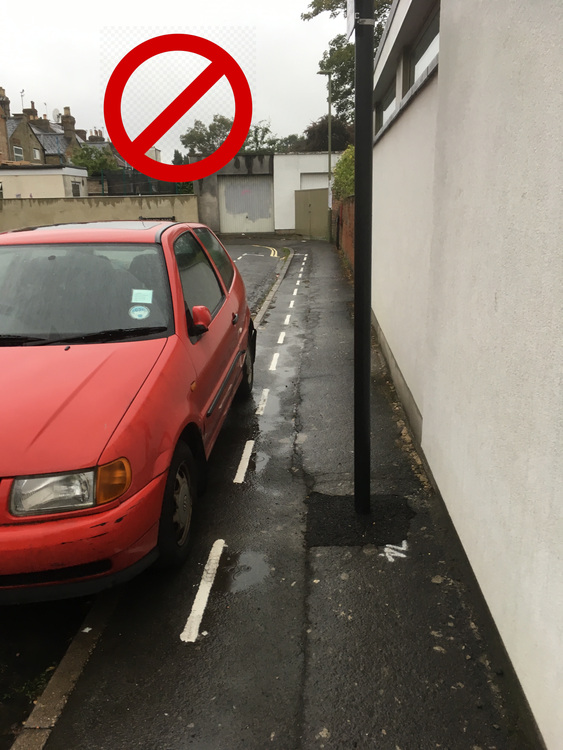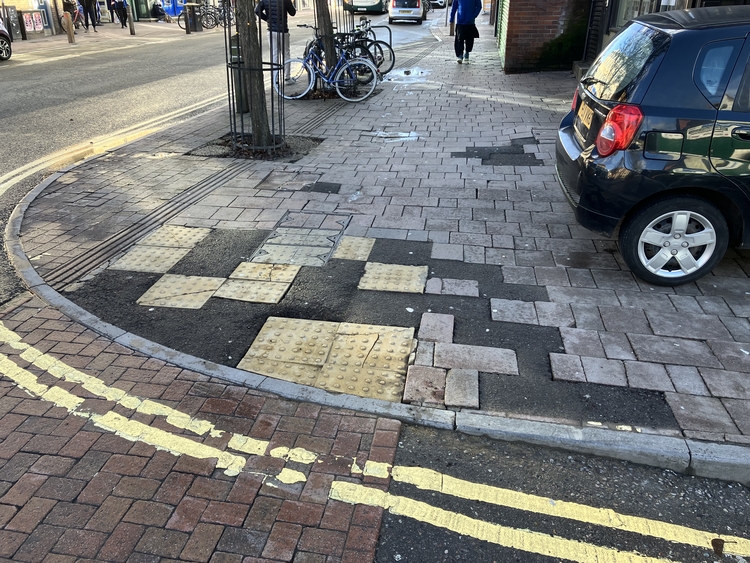At the moment, footways in Oxfordshire fall into the cracks between different county teams. Parking, Road Agreements, Transport Development Control, Active Travel, Maintenance, and different Localities teams all implement or oversee schemes that affect footways, but no one has overall responsibility for them. A single county team should be given responsibility for footways, with a watching brief over all schemes that affect them. That could be a beefed up Active Travel team, or a Parking team with an expanded mandate.
Walking is at the top of the transport hierarchy in the Local Transport and Connectivity Plan, but lower-level policies and guidelines do not reflect that. Controlled Parking Zones are designed and implemented with car parking as the primary concern, road safety as a secondary concern, and pretty much no consideration to the effects on footways. The "Detailed Design Elements" section of the county Street Design Guide has three pages on cycle parking, nine pages on car parking, and treatment of drainage and "innovation", but doesn't even mention footways. The Road Agreements Team has policies which actually prevent the use of entrance kerbs in accesses to new developments (which would allow footways to remain level). Cycle and scooter parking is still being provided on footways, or in locations that can only be accessed via them. And so forth.
Footway problems are intimately connected with car parking provision and enforcement. Pavement parking is one obvious link, with pavement parking places explicitly marked in some places and prohibited elsewhere by the Traffic Regulation Orders creating Controlled Parking Zones. But even where pavement parking is explicitly banned, there is no enforcement. Others connections include impairment of footways by dropped kerbs put in for off-street parking, CPZ signs that obstruct footways, parking damaging footway surfaces, and so forth.
A lack of cycle parking often results in ad hoc cycle parking that obstructs footways. In many cases, cycle or scooter parking is located on footways, or at footway level, which as well as obstructing footways encourages people to cycle or scoot on them.
Dropped kerbs are currently being implemented by sloping the entire footway, conveniencing occasional - perhaps twice a day - car movements over hundreds, in some cases thousands of people walking or wheeling every day. Hedges and trees planted on private property that overgrow the footway are allowed to reduce its width to 1.2m.
Most of this lies in the county's domain, but the city and district councils have some responsibility. Garbage collection, for example, involves bins placed on footways - and put back on them after emptying - instead of on the edge of properties (or in on-carriageway bin stores). And private waste collections (by companies such as Biffa or Veolia) could be better regulated.
My suggestions for fixing this mess:
1) give some county team clear responsibility for footways and footway quality
2) change the guidelines and policies of different county teams to, first and foremost, stop making things worse:
- entrance kerbs (keeping the footway flat) should be prescribed in new developments or with new off-street vehicle accesses
- wherever possible scooter and cycle parking should go on the carriageway, not on the footway (if the e-scooter scheme is ever made permanent, the scooter parking needs to be shifted to the carriageway)
- EV charging points, sign poles, and so forth should go on buildouts into the carriageway rather than onto footways
- contractors or utility companies digging up footways should be required to return them to flat and even
- how much private landowners are allowed to let vegetation to encroach onto public land and curtail footway widths should be reduced (instead of allowing effective footway widths to be reduced to 1.2m, perhaps bar any encroachment of 0.2m or more that would reduce the effective width below 1.5m).
3) and some improvements that would be relatively easy
- prioritise footways for gritting, leaf clearing, etc.
- while works are in progress that block footways, providing safe and accessible alternative routes for walking and wheeling should be prioritised.
- mandate parking wardens to enforce the already existing ban on pavement parking inside Controlled Parking Zones.
- include footways when streets or roads are being "refreshed" or resurfaced.
4) to go alongside footways, adopt a sustainable kerbside strategy.



Yes, yes, yes.
As to pavement width, I was shocked at the lack of enforcement when I moved here.
In Kent a lovely highways officer when alerted by me would I identify the landowner responsible and send them a strict legally worded letter instructing them to trim back any encroaching vegetation so that pedestrians could enjoy 'the full width of the pavement.'
Agree with all of the above. The issue of who is responsible is highlighted by current issues of the Abingdon Road. Where the County and City have different responsibilities where a listed wall could collapse, and the pedestrians are excluded from the pavement. Interesting judgements about safety where a wall could collapse so pedestrians have to step into the road to be "safer". And it is now over 3 months.
Similar for the Pipe Bridge (closed almost 3 years). Not safe to walk over, but safe to go under on a boat or foot!
Utilities need to repair leaving a good surface. But they also need to show the same priority to reopen that would be shown for roads.
Also I'd add - zebra rather than pelican crossings wherever possible. And shorter waits where pelican crossings are used. Why do we have to wait so long to cross the entrance to the Westgate carpark?
And the lack of any sound on some pelican crossings. How do blind people know they can cross?
Enforcement seems essential
I'm all for less anti-pedestrian timings on crossings, but that's a different problem - and in requiring reallocation of space/time from motor traffic, one that's more difficult politically. In contrast, the changes to footway policies I suggest should not be so hard.